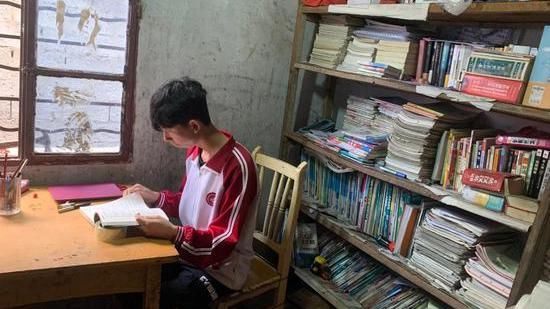- · 《继续教育研究》栏目设[05/29]
- · 《继续教育研究》数据库[05/29]
- · 《继续教育研究》收稿方[05/29]
- · 《继续教育研究》投稿方[05/29]
- · 《继续教育研究》征稿要[05/29]
- · 《继续教育研究》刊物宗[05/29]
高等教育普及背后:那些“家庭第一代大学生”
作者:网站采编关键词:
摘要:对孙川而言,这个夏天注定与众不同。他因为“收到清华录取通知书前还在工地打工”上了热搜,得到了不少公众的关注。 这名来自四川凉山彝族自治州一个深度贫困区的少年平时除了
 对孙川而言,这个夏天注定与众不同。他因为“收到清华录取通知书前还在工地打工”上了热搜,得到了不少公众的关注。
对孙川而言,这个夏天注定与众不同。他因为“收到清华录取通知书前还在工地打工”上了热搜,得到了不少公众的关注。
这名来自四川凉山彝族自治州一个深度贫困区的少年平时除了学习,还需要照顾弟弟妹妹,帮着父母干农活。生活虽苦,但他没有放弃,十年寒窗苦读,他最终实现了自己的理想。作为家里的第一个大学生,即便拿到了理想大学的“邀约函”,他也主动选择在开学前去工地打工,希望通过自己的双手减轻父母的负担,赚取大学生活费和学费。
This summer, the name Sun Chuan topped the search charts on China's microblogging website Weibo. The 17-year-old was reportedly toiling at a construction site when he was informed about being accepted as a student at Tsinghua University, China's top university.
Born in one of China's extremely poor areas, southwest China's Liangshan Yi Autonomous Prefecture, Sun became the first member of his family to go to college. His father is a migrant worker and his mother teaches at a local primary school. As the eldest child, he had to babysit his younger siblings and help his parents on the farm.
After sitting for his college entrance examination in July, he landed a job at a construction site to mitigate the family's financial woes and save some money for his upcoming college life.
孙川的故事,正是许多像他一样的“家庭第一代大学生”群体的缩影。尽管出身贫寒,但他们的学业表现毫不逊色,凭借刻苦学习,他们重新书写了自己和家庭的命运。
随着高等教育逐步普及,越来越多没有大学教育背景的家庭实现了“零的突破”。清华大学教育研究院通过数年的跟踪研究,总结了从2011年至2018年全国本科生家庭情况,发现超过70%的大学生都属于家庭的第一代大学生,在这些“第一代大学生”当中,69.74%来自农村,70%非独生子女,76.89%父母从事普通职业。
2019年,华东师范大学高等教育研究所对家庭第一代大学生在校情况进行了调查。研究人员设定了三个指标对不同成长环境下的大学生表现进行评估,包括考试不及格次数、专业排名和获得奖学金级别。研究显示,来自城市与农村的家庭第一代大学生之间没有显著差异。
Like Sun, many in China are first-generation college students. According to a research conducted by Tsinghua University, over 70 percent of China's university students are first-generation college goers, among them 69.74 percent have rural roots.
Despite their family background, the first-generation college students from rural households perform just as well as their urban peers, according to a research done by East China Normal University.
Researchers evaluated students' performance based on three indexes: times of exam failures, score ranking and scholarships. Their research discovered no significant difference between the two groups.
随着近几十年来中国经济的快速发展,高等教育逐步由精英教育进入普及化阶段,据统计,高等教育毛入学率从1990年的3.4%跃升至2019年的51.5%。伴随着昔日的“象牙之塔”变身为“大众之厦”,更多寒门学子圆了自己的大学梦。
这与近年来中国政府推进教育事业健康发展,并加大对国民教育的投入密切相关。2019年,中国在教育上的支出总计为5.02万亿元,政府教育支出超过4万亿元,教育经费占国内生产总值比例继续保持在4%以上。
不仅是高等教育,“十三五”期间,教育公平也在向广度和深度拓展。教育部高等教育司司长吴岩指出,未来中国高校还将继续发挥作用,成为推动国家发展的战略引擎。
With China's fast economic development in recent decades, the country's higher education has entered the universal stage as the gross enrollment ratio in higher education (GER) jumped from 3.4 percent in 1990 to 51.5 percent in 2019.
China attaches great importance to the development of education. Its official data shows that the government expenditure on education has increased continuously over the years.
In 2019, China spent a total of 5.02 trillion yuan (745 billion U.S. dollars) on education. The figure was over four trillion yuan in government expenditure on education. The public expenditure on education in GDP stood at 2.41 in 1995, while the ratio increased to 4.26 percent in the ensuing two decades.
Even though the spending on education per student has improved a lot in the last decades, it is still far behind developed countries. Fast economic development has widened the education inequality gap as some elite schools in the big cities coexist with the vast numbers of schools operating on a completely different level of quality.
During a recent conference, Wu Yan, director of the Higher Education Department of the Ministry of Education, said that China will further accelerate its \"massification\" of higher education and improve its quality nationwide, aiming to make it a strategic engine for the development of national soft power and hard power.
文章来源:《继续教育研究》 网址: http://www.jxjyyj.cn/zonghexinwen/2020/1017/782.html
上一篇:教育部及各省第二学位政策
下一篇:布鲁金斯学会:取消与中国文化教育交流的代价